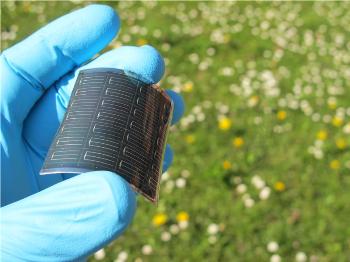A team of scientists led by Ayodhya N. Tiwari, at Empa, the Swiss Federal Laboratories for Materials Science and Technology, have further improved the power conversion capabilities of flexible solar cells manufactured utilizing copper indium gallium (di)selenide or CIGS.
The scientists have achieved a record efficiency of 18.7% surpassing their earlier record of 17.6% achieved in June 2010. The increased energy efficiency results have received independent certification from Freiburg, Germany located Fraunhofer Institute for Solar Energy Systems.
 Flexible thin film CIGS solar cell on polymer substrate developed at Empa
Flexible thin film CIGS solar cell on polymer substrate developed at Empa
The Empa team worked closely with scientists working with FLISOM, a start-up company, which is currently improving and commercializing the developed technology. The team achieved the improved efficiency in cells through a reduction in recombination losses by augmenting the structural attributes of the CIGS layer and used a proprietary deposition process at low-temperatures for developing the layers as well as in place doping with Na in the end phase. The result also proved the efficiency of utilizing polymer films as carrier substrates over the use of metal foils to achieve better conversion efficiency. The achieved results also established that the low temperature deposition process while improving the efficiency of flexible solar cells over metal as well as polymer foils does not require the commonly used barrier coatings over the substrate surfaces.
According to Tiwari, the achieved 18.7% efficiency of flexible CIGS solar cells fills in the perceived performance gap between it and the CIGS thin film cells or polycrystalline silicon (Si) wafers on glass. He anticipates that the flexible and lightweight CIGS solar cells with matching efficiencies will bring a shift in the solar cells usage and allows cost- effective production of solar power in the future. The new CIGS solar cells while offering improved efficiency than the currently available cells in the market can be manufactured utilizing a roll-to-roll process. Moreover, the flexible and lightweight solar modules also offer increased savings in terms of easy installation, use of light weight structural and transportation thus reducing the balance of system costs.